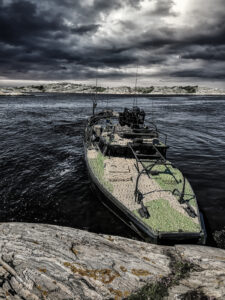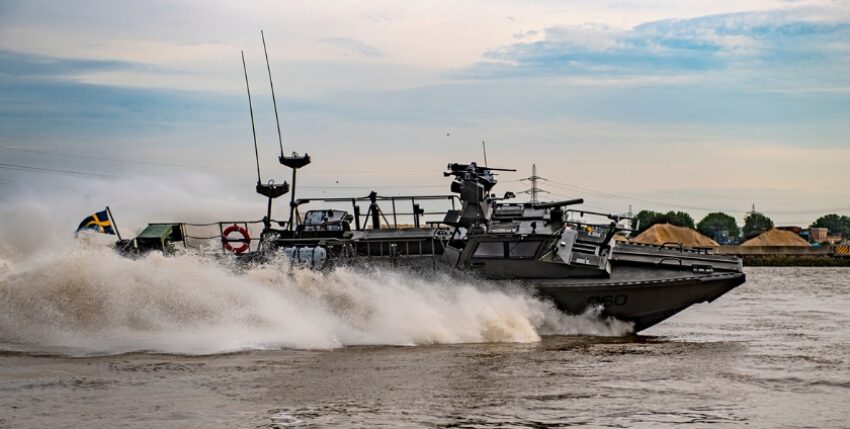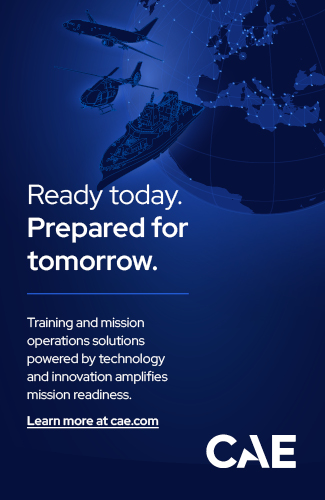With the CB 90, Saab offers a powerful combat boat. The integration of the Autonomous Ocean Core now opens up further utilisation options.
With the CB90 (CB stands for Combat Boat) from its subsidiary Docksta, Saab is demonstrating how a unit originally designed for manned operation can be optimised for uncrewed operation with the help of autonomous technologies.
CB90 is already in service with several navies for amphibious, coastal and riverine operations. In addition to the Royal Swedish Navy - where it is prioritised for amphibious purposes - the CB90 is used by the US Navy, the Ukrainian, Norwegian, Malaysian and Mexican navies as well as the Greek Coast Guard. According to Saab, more than 250 CB90s are in service worldwide.
Its speed and stealth characteristics make the CB90 an ideal naval weapon for operations in Swedish coastal waters and the islands off the mainland. Saab is taking a new approach with its Autonomous Ocean Core technology concept. The control system enables the CB90 to operate autonomously, further enhancing its capabilities.
Original ability

CB90 was designed to carry around 20 people and cargo, which it can transport at high speed and manoeuvrability in and around coastal waters. The boat can draw on a wide range of equipment and armament. These include stabilised and remotely controlled weapon stations (RWS). As a platform, the CB90 allows flexibility, which makes different armament and payload constellations possible.
Made entirely of aluminium, the vehicle is designed for use in various environmental conditions, both in tropical and Arctic waters. It can be transported to its deployment regions by air, land and sea.
In the latest version, the CB90 Next Generation (NG) - known as the CB90 HSM in the Swedish Navy - the combat characteristics have been optimised with a new command and information system and the Saab Trackfire RWS. Added to this are improved manoeuvring characteristics with a new control system and revised waterjet drive.
According to Saab, the 16.3 m long and 24.5 tonne ship has a maximum speed of 45 kt and can reach a range of 300 nautical miles at a cruising speed of 38 kt in sea state 1.
With its NBC protection, the CB90 can be used in all crisis and combat scenarios. The lightweight polyethylene lining and safety glass offer ballistic protection. The bow ramp is also designed to enable rapid deployment of personnel and material on unprepared beaches and coasts.
The boat can be used not only by a navy, but also by other operators thanks to its adaptability to operational requirements. Customers can choose from a wide range of navigation and monitoring systems, propulsion systems, command and information systems, sensors, (remotely) controllable weapon stations, mounts and guns. The vehicle can also be configured with regard to the number of seats or bunks required.
More autonomy
It made sense to give a vehicle like the CB90 more autonomy. On the one hand, the risk of a mission is reduced, and on the other hand, there are economic advantages. Response times can be shortened because you are not dependent on the availability of personnel. Geographical coverage can be increased through co-operative operations between autonomous units.
The addition of autonomous functions to the CB90 significantly increases the unit's capabilities. "The CB90's autonomy makes it ideal for missions that are difficult, require endurance or are too dangerous for personnel," said Anders Hellman, Vice President and Head of Business Unit Saab Kockums Docksta, in an interview with Marineforum on 12 February. Typical tasks for the boat include intelligence, surveillance and reconnaissance (ISR), communications and logistics.
A key step in the development of the CB90's autonomous capabilities is the addition of Saab's new Autonomous Ocean Core. "The control system is fully developed and operational today," said Hellman. "It was developed on board the CB90 and is therefore very well suited to improving the operation and performance of the vessel."
"The Autonomous Ocean Core control system enables unmanned missions of the CB90 ....Es to remotely control and operate the vessel," continues Hellman. "It is a ship-independent control system with an open architecture designed for easy integration with propulsion, propulsion and ship automation systems. The system is also open for the integration of various sensors and effectors."
"Operators simply enter the ship's parameters into the motion control system to enable operation without a crew. The system is ready to perform tasks with or without additional functions," Hellman explains.
Autonomous Ocean Core brings benefits for both platform operations and platform performance, Hellman explained. In terms of platform operations, it allows unmanned and autonomous small and medium-sized vessels to operate safely and predictably. In terms of platform performance, it provides better surveillance and therefore a tactical advantage. The concept allows users to focus on mission execution and equipment without having to consider basic control and safety mechanisms, as the architecture enables plug-and-play integration of the payload.
"With the versatility of CB90, Autonomous Ocean Core opens up new possibilities and improves existing ones at the same time," says Hellman.
Autonomous Ocean Core is available on the new CB90 platforms. However, according to Hellmann, "it can also be integrated relatively easily on CB90s already in operation."
Hellman argues that the new technology concept helps to underpin the operational reliability of CB90 in autonomous operation. Autonomous Ocean Core is designed to provide precise control over navigation, speed and obstacle avoidance in a variety of operating conditions, he explained. "The basic operational reliability of the platform is solid and designed for future requirements as technology advances," he said. "However, we are continuously working to develop the capabilities and further improve the perception and decision-making capabilities to ensure operational relevance."
Hellmann explains the most important development steps to be taken for Autonomous Ocean Core in the coming year: the expansion of autonomous mission behaviour, the integration of effectors and software developments that enable the integration of system behaviour by third parties.
The development of the CB90 in conjunction with the Autonomous Ocean Core reflects the broader naval warfare approach of integrating unmanned platforms with each other and with manned units. "The versatility of CB90 allows it to carry a range of payloads and effectors. The system can deploy smaller unmanned ships or effectors," said Hellman.
"Another option is to deploy the CB90 with Autonomous Ocean Core from larger vessels. ... The fact that the Autonomous Ocean Core control system is designed to be platform-independent makes its deployment possible on both surface and sub-surface units." According to Hellman, this opens up "a multitude of possibilities and deployment options for the units and missions the system can support."
New approaches
The introduction of novel platforms, systems and concepts into the navies' concept of operations - especially in an area such as autonomous capability - is often accompanied by enduring and new approaches to support, including training, logistics and maintenance.
To optimise the use of autonomously operating units, as in the case of CB90 boats controlled by Autonomous Ocean Core, Hellman said a new and flexible force structure is required with personnel trained in remote operations, mission planning and understanding system boundaries. "Roles will shift from direct ship control to mission oversight, tactical coordination and ship monitoring," he said. "In turn, training should focus on system behaviour and integration of traditional or ongoing naval operations to ensure effective deployment," he continued.
For CB90s, the training required varies depending on the different functions, Hellman explained. Technicians who have to carry out all maintenance work, including the maintenance described in the workshop manuals, complete a five-week course. This covers all systems on board, from the waterjet drives to the electrics. Operators on board usually complete a two-week course. These training requirements for operators and maintenance personnel assume that the personnel concerned already have experience of working on or with other ships, says Hellman.
For Autonomous Ocean Core, programmes have been designed to be as user-friendly as possible to support effective training. They are designed to ensure the amount of training required is proportionate to the requirements for safe operation of the unit operating the system.
Hellman explained that the use of autonomy can reduce a navy's overall training requirements. "If personnel are trained to operate a ship remotely and can operate multiple ships simultaneously, fewer people need to be trained to operate those ships." Another advantage he sees is that a ship that can rely on trained remote operators is available for operations more quickly.
In terms of logistical and maintenance support for a remotely piloted platform like the CB90, "logistical support for autonomous operations relies on pre-mission preparation, remote monitoring and scalable resupply options," Hellman said. "Again, forward planning is especially important to anticipate maintenance needs," he added.
Dr Lee Willett is a freelance author specialising in maritime, defence and security issues.
Lee Willett










